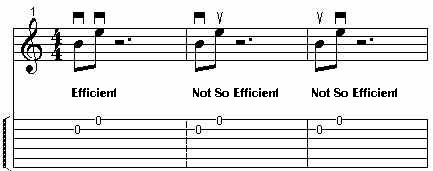Mind-Bending Upstroke Exercises
If you’re like me, you’ve never paid that much attention to upstrokes. Like many flatpick-wielding guitarists, I’ve concentrated on alternating picking technique for most of my playing life. And that makes sense – it is certainly the most versatile, general purpose technique that there is. You also probably have a smattering of downstroke-based ascending arpeggios in your repertoire (see example 1). If this is all you’ve done, you’ve ignored perhaps 30% of your picking potential. These exercises will start you on the road towards harnessing that potential.
Example 1:

What I’ve found, though, as I’ve delved into the guitar techniques of Django Reinhardt and Jim Hall, are systematic exploitations of the technique known as “sweep picking.” This refers to the technique of eliminating the inefficiencies that alternating picking imposes on you when you change strings. The simplest case: if you were to play two notes in succession on adjacent strings, sweep picking would dictate that you sound both notes with the same direction stroke, while alternate picking would make you move that pick a lot more (example 2).
Example 2:

Sweep picking is not universally applicable – there are many riffs which don’t lend themselves to this technique – but there are some passages that are virtually impossible to play at full speed without it. The basic principle of sweep picking is to put an odd number of notes on each string – typically 1 or 3, as in example 3. Note that having an even (2) number of notes on the top string facilitates the change of pick direction.
Example 3:

In order to fully integrate sweep picking into your playing, your upstrokes must become as powerful, controlled and fluid as your downstrokes. Example 4 will go a long way towards making that happen if you are sure to accent the first note of each triplet and play the other two softly, regardless of where the up and down strokes fall.
Example 4 is
- the key to basic phrasing flexibility
- much longer than it looks (you need to repeat the pattern about 6 times before the cycle is complete)
- both devilishly complicated and quite simple
- not a finger-twister at all, but quite a mind-twister
(Okay, look – maybe it’s easy for you. Then you’re beyond this column. It wasn’t easy for me at first.)
Let’s explain it before playing it. On the surface, the structure is simple: you start out by playing 3 adjacent notes on the 5th string, then move the same pattern up to the 4th, then up to the 3rd, then to the 2nd, “sweeping” the transition from each string to the next with successive downstrokes. You continue this pattern to the 1st string, but only play two notes in order to facilitate a change of direction from ascending to descending. At this point, we start sweeping with upstrokes bridging adjacent strings instead of downstroke. At this point, the accents start to diverge from the note crossings, and you have to mentally track both, emphasizing the first note of each beat (which, in this measure, happens to fall on a downstroke) while being careful to cross strings with un-emphasized upstrokes. This pattern continues down to the 6th string, where two notes are played and the direction reverses again. The G# in measure 3 is usually where I lose it if I’m not paying enough attention – maintaining the correct accents throughout that second ascent, where all the accents occur on upstrokes, can be a challenge. And the challenge continues. Since the string crossings, stroke direction and the emphasis are all moving “out of phase” with one another, this exercise gives you the raw technique that you’ll need to play a wide variety of phrasings using optimal patterns of up-and-down strokes.
It seems complicated. And yet, once you grasp the pattern, it’s really easy to remember and play any time, during any warmup.
Example 4:
 etc.
etc.
(continue pattern until exhausted)
Example 5 is a straightforward arpeggio exercise that uses both up and down strokes. Example 6 is a 4-string variation.
Example 5:

run it up and down the fretboard, translate the shape to all other sets of 3 adjacent strings.
Example 6:
 etc.
etc.
When you’ve mastered these exercises at swift speeds, you’ll have all the technique essentials to play blazing-fast swept licks.
